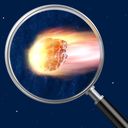Meteor showers rain clues about the solar system

Hundreds of years after meteor showers were first observed, these cosmic spectacles are still delivering scientific clues to researchers on Earth.
Why it matters: Meteors bring information about their parent asteroids and comets, which carry evidence of the solar system's history and help scientists to study the origins of Earth and other planets.
- Understanding meteor showers also allows space agencies and companies to keep their spacecraft in orbit safe by knowing more about the environment that surrounds them.
- Rocks and dust can impact satellites at high speed, potentially damaging them or taking them out of service altogether.
What's happening: November and December are banner months for annual meteor showers, and scientists around the world will be keeping an eye on these shooting stars.
- The Taurid meteor shower is ongoing, and the Leonid meteor shower is expected to peak mid-month.
Each meteor shower has different characteristics.
- "Taurids produce a lot of fireballs, not because they're fast but because they're more pebble- and baseball-sized. Whereas the Leonids are fast, extremely fast, but they're specks of dust," NASA astronomer Bill Cooke tells Axios.
- Fireballs are defined as meteors that appear about as bright or brighter than Venus in the night sky.
- The Geminid meteor shower — often one of the best of the year — will peak in mid-December, bringing bright fireballs to dark skies.
How it works: Researchers use powerful radar systems around the world to survey the sky for meteors.
- Some of those radar systems run 24/7, but other, more specialized and powerful instruments that can pick up on extremely small meteors only operate for a short amount of time because of the cost to run them.
- Citizen scientists with their own backyard cameras also contribute important data to the field, Quanzhi Ye, an astronomer at the University of Maryland College Park, tells Axios. Those contributions can include information about the frequency and timing of meteors.
- "You don't need to have a million dollar lab in order to do meteor observations," Ye said. "Sometimes you can just use your eye or just spend like a few hundred dollars and build your own cameras."
The big picture: Meteor showers happen when Earth passes through trails of debris left behind by comets and asteroids.
- The planet reliably crosses paths with some of these debris trails at the same time each year. Other meteor showers are random occurrences, depending on what new comets and asteroids have passed through Earth's orbit at any given time.
- By tracking the streak of a meteor, measuring its speed, its brightness and even picking apart its color, scientists are able to learn more about the asteroid or comet that left behind that dust and rock without ever having to visit it directly.
Zoom in: Meteor science is still challenging long-held ideas about the solar system's formation.
- A fireball observed over Canada in 2021 came from a part of space thought to be populated by icy comets.
- But when scientists observed the streaking meteor, they found it had the qualities of a rocky object, challenging theories for how our solar system evolved.
The intrigue: A new study in the Astrophysical Journal suggests a 2014 fireball was actually an interstellar object.
- Scientists are also searching for other possible interstellar meteors, hoping to uncover more objects like these.
- Finding interstellar meteors would allow scientists to learn more about other solar systems and the objects within them without sending a mission out to visit one.
What to watch: Meteor shower science is a small scientific field, and many meteor scientists are focusing on reanalyzing research that was done decades ago by applying new techniques to see what earlier researchers might have missed.
- "Worldwide, there are about 100 of us," Cooke adds. "A lot of our knowledge is based on work that was done in the '50s and '60s, and we're not really sure how good it is."
- For example, scientists are able to see far more high-speed meteors now than in the past by correcting for an instrument issue that made it harder to see these types of meteors in earlier years.